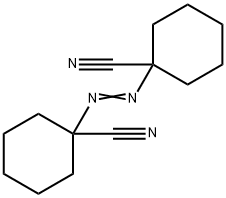2094-98-6

Product Name:
1,1'-Azobis(cyanocyclohexane)
Formula:
C14H20N4
Synonyms:
1,1′-Azobis(cyanocyclohexane);ACHN
Inquiry
CHEMICAL AND PHYSICAL PROPERTIES
| Physical Description | 1,1'-azodi-(hexahydrobenzonitrile) appears as a white to light colored solid substance. Insoluble in water and more dense that water. May cause irritation to skin, eyes, and mucous membranes. May be toxic by ingestion. If exposed to high temperatures or flames this material may ignite and burn with an intense flame. Dust may form an explosive mixture in air. |
|---|
SAFETY INFORMATION
| Signal word | Danger |
|---|---|
| Pictogram(s) |
 Flame Flammables GHS02  Exclamation Mark Irritant GHS07 |
| GHS Hazard Statements |
H242:Self-reactive substances and mixtures; and Organic peroxides H315:Skin corrosion/irritation H319:Serious eye damage/eye irritation H335:Specific target organ toxicity, single exposure;Respiratory tract irritation |
| Precautionary Statement Codes |
P210:Keep away from heat/sparks/open flames/hot surfaces. — No smoking. P235:Keep cool. P302+P352:IF ON SKIN: wash with plenty of soap and water. P305+P351+P338:IF IN EYES: Rinse cautiously with water for several minutes. Remove contact lenses, if present and easy to do. Continuerinsing. P370+P378:In case of fire: Use … for extinction. P403:Store in a well-ventilated place. |
COMPUTED DESCRIPTORS
| Molecular Weight | 244.34 g/mol |
|---|---|
| XLogP3 | 3.4 |
| Hydrogen Bond Donor Count | 0 |
| Hydrogen Bond Acceptor Count | 4 |
| Rotatable Bond Count | 2 |
| Exact Mass | 244.16879665 g/mol |
| Monoisotopic Mass | 244.16879665 g/mol |
| Topological Polar Surface Area | 72.3 Ų |
| Heavy Atom Count | 18 |
| Formal Charge | 0 |
| Complexity | 368 |
| Isotope Atom Count | 0 |
| Defined Atom Stereocenter Count | 0 |
| Undefined Atom Stereocenter Count | 0 |
| Defined Bond Stereocenter Count | 0 |
| Undefined Bond Stereocenter Count | 0 |
| Covalently-Bonded Unit Count | 1 |
| Compound Is Canonicalized | Yes |
PRODUCT INTRODUCTION
description
1,1'-azodi-(hexahydrobenzonitrile) appears as a white to light colored solid substance. Insoluble in water and more dense that water. May cause irritation to skin, eyes, and mucous membranes. May be toxic by ingestion. If exposed to high temperatures or flames this material may ignite and burn with an intense flame. Dust may form an explosive mixture in air.